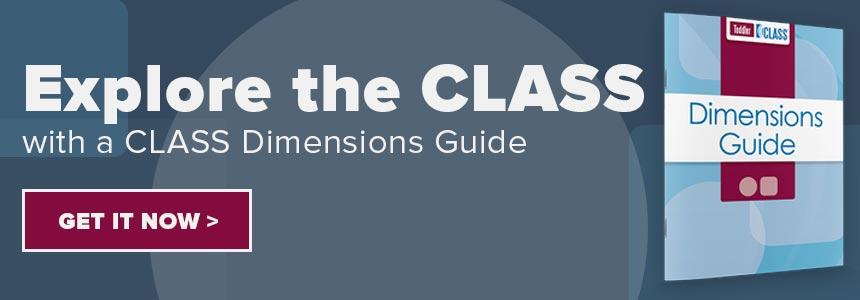
When teachers hear CLASS tool, often the first thought that comes to their mind is asking children open-ended questions. And while asking “how” and “why” questions is extremely important in helping to foster and support language and concept development, we cannot have effective interactions with these questions alone. There is so much more to the CLASS tool!
The Recipe
Let’s think of the CLASS tool like the elements of a beautiful birthday cake. First, we need a recipe to help guide us towards a desired outcome—whether we are talking about a cake or effective interactions between teachers and children. Our recipe for effective interactions is the CLASS Dimension Guide. It gives us the ingredients we need to plan and take advantage of everyday exchanges with children.
The Ingredients
Now, let’s think about the specific parts of the CLASS tool. A cake is more than ingredients tossed into a bowl. Throwing flour, salt, sugar, baking powder, butter, and milk together in a haphazard ratio will not reliably produce a cake any more than believing that asking open-ended questions alone will result in desired academic and social outcomes for children. We need all of the various CLASS dimensions just like we need all ingredients to bake a cake.
Understanding exactly what each of the dimensions means is as fundamental as knowing the difference between flour and baking soda. A good teacher reviews and researches these “ingredients” and creates a classroom environment that children enjoy while providing them with the emotional and educational nourishment that supports their growth into healthy, happy individuals.
- Positive Climate, Teacher Sensitivity, and Regard for Student Perspectives—these CLASS ingredients support children’s independence, excitement about learning, and trust with a teacher.
- Next, we add equal amounts of Behavior Management, Productivity, and Instructional Learning formats to help children get the most learning out of each day. These dimensions are also necessary in teaching children how to self regulate.
- Lastly, we mix in Concept Development, Quality of Feedback, and Language Modeling to ensure we support cognitive and language skills.
Tweaking the Recipe
Just as cooking times vary based on the type of oven, so do classroom dynamics. We need to take into account that what works for one group of children, may need to be altered slightly for different personalities, needs, and backgrounds. A skilled teacher, like a baker, understands when and how each of these dimensions is best implemented and combined with the others.
So there you have it: combining the Dimensions Guide recipe with all the CLASS ingredients is the only way to have high-quality interactions in your classroom. And remember, it takes time to figure out how to incorporate each of the dimensions. Before you know it, your CLASS-cake will be complete.
Time to celebrate!

